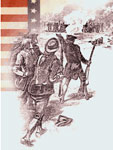Two-Year High School U.S. History Programs

Are there any schools/teachers using 2 years (3 or 4 semesters) of U.S. history in their high school (especially AP programs)? We are contemplating it and I'd like input into its successes and failures.
Very few public schools offer two years of U.S. History at the high school level. Two states, however—Alabama and New Jersey—mandate it. In Alabama, U.S. History is divided into two courses: one covering the period before 1877, and the other covering the period after it. In New Jersey, all public schools must provide two years of U.S. History, including New Jersey history in the process.
Of course, parochial and independent schools are free from these constraints. Consequently, it is much more difficult to generalize about what is done in such settings. Some schools cover the entire sequence of U.S. History in middle school, and then again in high school. Some schools cover the pre-Reconstruction period in middle school and the post-Reconstruction period in high school. And, some schools divide U.S. History into two high school courses, in addition to whatever work is done at the middle school level.
With specific regard to AP classes, some independent schools do teach U.S. and world history in the first few years of high school, allowing students to choose an AP class in 11th or 12th grade. While the advantage of this is that students often feel more prepared for the end of year AP test, the disadvantage is that courses often overlap without providing greater depth of focus.

